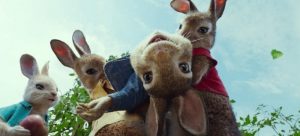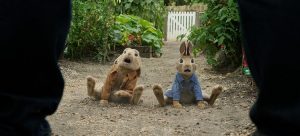
Scene from ‘Peter Rabbit’ (source: https://www.imdb.com/title/tt5117670/mediaindex?ref_=tt_pv_mi_sm)
Of course, the new Peter Rabbit film was not going to be a faithful adaptation of Beatrix Potter’s slim children’s book. While some reviewers claim Potter would have ‘despised this movie’, or that it would have had her ‘spinning in her grave’, others expected alterations made to a story of over 100 years of age.
In the original, Peter Rabbit enters the garden of a Mr McGregor to steal vegetables and is very nearly caught, his mother punishing him by denying him dinner. In the film, Peter, his sisters and Benjamin Bunny go to war against Mr McGregor’s wildlife-hating nephew, who moves in after his uncle dies. Both sides enter combat with rather painful tricks involving traps in bed, and an electric fence. The wildlife-friendly neighbour Bea, obviously referencing Potter herself, tries in vain to convince young Thomas McGregor of the goodness in animals.
Despite the obvious differences and updated plot devices, the overall storyline and the integrity of Peter’s rascal personality largely carry the spirit of the original. A cleverly funny addition to the original story is the disruption of the dispute between Peter and McGregor’s nephew by Bea who, loving the wildlife, wants her attractive neighbour to get along with it. Of course, neither Peter nor McGregor want to displease her when she is in the room, but once she leaves the fight continues until she comes back in to discover McGregor reading to the rabbit. Much of the slapstick comedy is well planted, and especially the dialogue flows very well. While many critics cannot accept ‘animal twerking’ in an adaptation of an early 20th century children’s story, it is actually an accurate modern translation of the rebel child. Nonetheless there are some problematic features in the rabbit’s rebel behaviour, one of which led to public outrage.

Scene from ‘Peter Rabbit’ (source: https://www.imdb.com/title/tt5117670/mediaindex?ref_=tt_pv_mi_sm)
As Peter, Mopsy, Flopsy, Cotton-Tail and Benjamin fight McGregor in his garden, they throw a blackberry in his mouth, because they know he is allergic to them. Tom Murray tweeted, ‘to support a movie that promotes bullying to children with food allergies is disgusting.’ As with this debate, over which the producers of the film had to apologise, the problem lies in the consideration of the target audience. It is questionable whether a children’s film should feature characters with a morale such as Cotton-Tail’s, who keeps jumping off rails and cars, cracking her ribs, only to ask Peter how many she has left to crack. Or the fact that Mrs Tiggy-Winkle keeps electrifying herself on the fence in order to get to the peanut butter spread on the wires. The film might be more enjoyable for adults in this way, but considering that Peter Rabbit is a children’s movie, it would have done better without this kind of humour.

Scene from ‘Peter Rabbit’ (source: https://www.imdb.com/title/tt5117670/mediaindex?ref_=tt_pv_mi_sm)
Despite the questionable flaws in these characters, Peter as well as his antagonist gain considerable depth throughout the development of their conflict. While McGregor’s growing romantic interest in Bea complicates his pretence, Peter has a lovely moment remembering his parents in a very self-referential way. The meta-fictional comments which Peter peppers the film with add an interesting ironic awareness to the adaptation, especially when he explains to Benjamin that his character flaw is to follow him into danger.
Peter Rabbit is a fast paced, and racy adaptation, at times too unaware of the lack of integrity children’s role models in films would require, but it is nonetheless well written and good fun to watch.